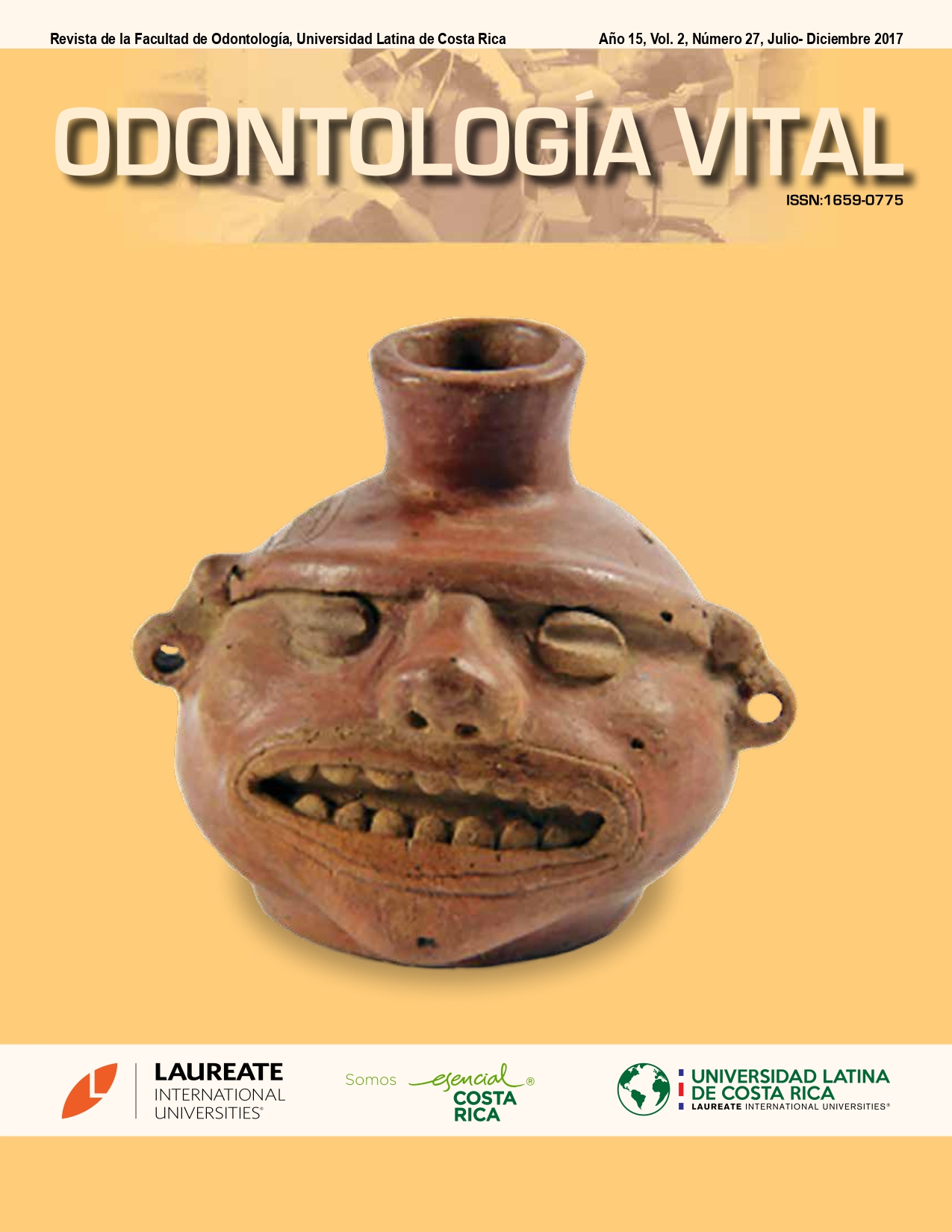Endoperiodontal lesions
DOI:
https://doi.org/10.59334/ROV.v2i27.209Keywords:
Endoperiodontology, endoperiodontal, endodontics, periodonticsAbstract
Endodontics and periodontics are the specialties of dentistry that deal with diagnosis, treatment, and prognosis of pulp and periodontal diseases, respectively. The set of both specialties give endoperiodontology, which studies injuries caused by diseases of the pulp and periodontum. The relation between the last two mentioned is very close due to its embryonic, anatomic, and functional interrelation. There is a variety of pulpal-periodontal communications, such as, dentinal tubules, lateral and accesory canals, apical foramen, palatogingival groove, root perforations, and vertical root fractures.
The endo-periodontal lesions are characterized by associating pulpal and periodontal pathologies in the same dental element. There lesions can be difficult to diagnose and prognosticate depending on contributing factors, such as, poor root canal treatment, coronal leakages, trauma, root resorption; etiologic factors like living pathongens (bacteria, virus, fungi), non-living pathogens (amalgams, root fillings, paper points), and intrinsec or extrinsec pathogens (cholesterol, Rushton hyaline bodies), and others. Namely, the flow of infection can start by a necrotic pulp which afterwards can affect the periodontum or viceversa. The treatment also varies in each diagnosed lesion, but they all require at least one of both endodontic or periodontal treatments.
Downloads
References
Abhishek Parolia, Toh Choo Gait, Isabel C. C. M. Porto, Kundabala Mala. (2013). Endo-perio lesion: A Dilemma From 19Th Until 21St Century. https://doi.org/10.4103/2229-5194.120514
Alcota, M., Mondragon, R., Zepeda, C. (2011). Tratamiento de una lesion endoperiodontal tipo Iii (Combinada O Verdadera): Reporte De Un Caso. https://doi.org/10.4067/S0719-01072011000100006
Ashutosh, Nirola, Sunanda, Grover, Ajay, Sharma, Damanjeet, Kaur (2011). Pulpal perio relations: Interdisciplinary diagnostic approach. https://doi.org/10.4103/0972-124X.82257
Babacar, Toure and Yves, Boucher (2013). Acute apial periodontitis and verital root fracture of the same tooth: A Case Report. https://doi.org/10.2334/josnusd.55.187
Barry, M. Eley, M. Soory, J. D. Manson. (2012). Periodoncia. (Sexta Edición)
Bartha, T., Gorzo I., Kertesz A. (2000). Therapeutic solution for a combined endo-periodontal lesion. A case report.
Bhaumik, Nanavati, Neeta ,V, Bhavsar, Jaydeepchandra, Mali. (2013). Endo periodontal lesion – A case report. https://doi.org/10.1177/2229411220130104
Bozan, Serhat Izol, Arzum, Guler Dogru, Fikret, Ipek, Ahmet, Gunay. (2012). Treatment of furcation lesions in de-vital teeth with B-tricalcium phosphate + hydroxyapatite graft material: A case report.
Tokunaga, C. Monguilhott, B. Crozeta, Schmitt Bonato, Serrato Coclho, Flares, Baratto-Filho, Sens Fagundes, (2012). Microbiological aspects of endoperiodontal lesion.
Jaquez Bairan, E. (2000). Lesiones endoperiodontales.
Foce, E. Endo-periodontal lesions.
Carranza, F. Klokkevold, P. Takei, H., Newman, M. (2012). Carranzas clinical Periodontology, (Eleventh Edition)
Gunnar, Bergenholtz, Preben, Horsted-Bindslev, Claes, Reit. (2011). Endodoncia. (Segunda Edición)
Rostein I. & H. Simon, J. (2006). The endo-perio lesion: A critical appraisal of the disease condition. https://doi.org/10.1111/j.1601-1546.2006.00211.x
Camilleri, J. (2008). The chemical composition of mineral trioxide aggregate. https://doi.org/10.1111/j.1601-1546.2006.00211.x
Esquenasi, J,. Capo, C., Batlle, A. (2009) Las lesiones endoperiodontales y su tratamiento. ¿Siguen aun vigentes?
Aguilar, L.C., Taketoshi, A., Garzón J.A., Gómez, A., Llamosas, J.A., Martínez, J.A., Ordóñez A.J., Pérez, R.E., Redondo C.F. , Villavicencio J., Arróniz S. (2014). Endoperiodontología Conceptos básicos.
Pineda Mejía M.E., Silva Infantes M., Salcedo Moncada D., Castro Rodríguez A., Terán Casafranca L., Ortiz Cárdenas E., Ochoa Tataje J., Gaitán Velásquez J., Watanabe Velásquez R. (2007). Uso clínico del MTA en el tratamiento de lesiones periapicales y perforaciones radiculares.
Rodríguez Franco N.I. (2004). Tratamiento de lesiones endoperiodontales con regeneración tisular guiada y colgajo por debridacion. Estudio comparativo.
Teniente Díaz de León O., Yánez Gutiérrez I. (2008) Relación endoperiodontal: Diagnóstico, tratamiento y pronóstico.
Saquete Martins P.R., Filho, Ferreira Da Silva L.C., Rabello Piva M., Machado Reinheimer D., Sue Dejean K. Spread of odontogenic infection originating from endo-perio lesion. Endoperiodontal lesion – Case report. https://www.sigaa.ufs.br
Raja Sunitha V, Pamela Emmadi,[...],and Vijayalakshmi Rajaraman. (2008).The periodontal – endodontic continuum: A review.
Samar Abdul Hamed Bds, Msc. (2011). Repair of root canal perforation by different materials.
Syed Wall Peeran, Madhumania Thiruneervannan, Khaled Awidat Abdalla, Marei Hamed Mugrabi. (2013). Endo-perio lesions.
Perdomo Masilly X., Ortiz Moncada C., Odalmis La O Salas N., Corona Carpio M.H., León Betancourt E.C. (2006). Principales aspectos clínicos de Las afecciones encoperiodontales.
Downloads
Published
Issue
Section
License
Copyright (c) 2017 Paulina Pesqueira Cinco, Héctor Carro Hernández

This work is licensed under a Creative Commons Attribution 4.0 International License.
Authors who publish with Odontología Vital agree to the following terms:
- Authors retain the copyright and grant Universidad Latina de Costa Rica the right of first publication, with the work simultaneously licensed under a Creative Commons Attribution 4.0 International license (CC BY 4.0) that allows others to share the work with an acknowledgement of the work's authorship and initial publication in this journal.
- Authors are able to enter into separate, additional contractual arrangements for the non-exclusive distribution of the Odontología Vital's published version of the work (e.g., post it to an institutional repository or publish it in a book), with an acknowledgement of its initial publication.
- Authors are permitted and encouraged to post their work online (e.g., in institutional repositories or on their website) prior to and during the submission process, as it can lead to productive exchanges, as well as earlier and greater citation of published work.







